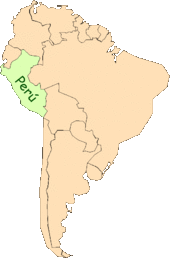
© UnknownMap indicating Peru's location on a map of S. America.
Lima - A magnitude-6.9 earthquake centered off Peru's central coast sent people running panicked into the streets Friday in cities badly damaged by a killer quake four years earlier. There were no immediate reports of damage or injuries.
People who had lost loved ones and homes in the earlier quake were badly shaken and some broke into tears.
"It felt like the one in 2007 because it was very strong," Felix Sihuas told RPP radio. He said he was buried under rubble for six hours in the Aug. 15, 2007, quake, which killed 596 people and largely destroyed the town of Pisco.
Friday's quake was considerably less violent in Lima, a city of 8.5 million people some 180 miles (290 kilometers). The capital shook for about 30 seconds in a series of moderate, swaying movements.
The
U.S. Geological Survey said Friday's quake was centered 31 miles (51 kilometers) south-southwest of Ica, a provincial capital of about 200,00 people which suffered widespread damage in the 2007 quake. It was at a depth of 21.7 miles (35 kilometers).